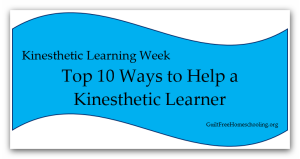 These tips will be helpful for parents of younger kinesthetic students, who need help learning how to learn.
These tips will be helpful for parents of younger kinesthetic students, who need help learning how to learn.
- Exercise first, before attempting lessons. Kinesthetic learners need to warm up their muscles to engage their brains.
- Forget about sitting still. Letting him use a swivel chair, rocking chair, video-rocker, or knee-chair (remember those?) can allow movement and use of muscles while sitting. Standing at a table or counter will work better for written assignments than trying to keep an energetic child seated. Use the floor as a work surface, instead of a table. Let the child sit or kneel on the floor or lie on his tummy to read, write, or do any lesson. Mom can still use a chair, but a child on the floor will be constantly in motion: reaching, stretching, balancing, and otherwise keeping those big muscles in use and warmed up, and by extension keeping his brain fully alert.
- Act out lessons, from buzzing like bees during a simple science lesson to role-playing Paul Revere by shouting “The British are coming!” to walking through a math word problem by pretending to be a train going 30 mph. Sometimes he needs to physically put himself into the lesson to mentally understand it. Precision and accuracy are not as important as improvisation and movement.
- An exercise ball, balance board, trampoline (mini- or full-size), jumprope, or any other activity can be used while the child answers questions or practices oral facts, such as math or spelling. A simple discussion while standing at the chalkboard/whiteboard can be completely transformed with the addition of roller-skates to the child’s feet.
- Extend your classroom to outdoors. Do lessons on the deck, practice spelling or math facts in the pool, use the treehouse for reading time or worksheets (or any lesson that won’t require Mom’s immediate help), or draw hopscotch grids on the sidewalk or driveway for a variation on facts practice.
- Run relays as “thinking time” before answering questions. Use balls, jumpropes, and other sports equipment as relay checkpoints: answer a question, spell a word, or recite a math fact at each checkpoint. Let him do it and make time for active movement. Place separate groups of flashcards or manipulatives in different rooms and let the child run back and forth to find pieces as they are needed in the lesson.
- Take a break to get the wiggles out. A kinesthetic learner starts to wiggle and move when his brain is beginning to shut down. Exercising and moving will wake it up again. To prevent him from wiggling or moving is to let his brain run out of gas.
- Make manipulatives BIG. Using flashcards made from full-size sheets of cardstock (or cereal box cardboard) will make them “TV-game show” size and require whole arm movements instead of just finger movements. Using an assortment of sports balls to represent a math problem in the grass involves arm and leg muscles, instead of using just fingers for small manipulatives on the table.
- Use chalk on the sidewalk/driveway or crayons/markers on large sheets of paper to encourage large muscle movements for writing, drawing, or problem-solving.
- Give him experiences in the other 3 styles to improve his overall learning abilities.
For further help, visit these links:
Learning Styles v. It’s a Syndrome
“Kinesthetic Learning” topic (including all of this “Kinesthetic Learning Week” series)
“Learning Styles” topic


 Guilt-Free Homeschooling is the creation of Carolyn Morrison and her daughter, Jennifer Leonhard. After serious disappointments with public school, Carolyn spent the next 11 years homeschooling her two children, from elementary to high school graduation and college admission. Refusing to force new homeschooling families to re-invent the wheel, Carolyn and Jennifer now share their encouragement, support, tips, and tricks, filling their blog with "all the answers we were looking for as a new-to-homeschooling family" and making this website a valuable resource for parents, not just a daily journal. Guilt-Free Homeschooling -- Equipping Parents for Homeschooling Success!
Guilt-Free Homeschooling is the creation of Carolyn Morrison and her daughter, Jennifer Leonhard. After serious disappointments with public school, Carolyn spent the next 11 years homeschooling her two children, from elementary to high school graduation and college admission. Refusing to force new homeschooling families to re-invent the wheel, Carolyn and Jennifer now share their encouragement, support, tips, and tricks, filling their blog with "all the answers we were looking for as a new-to-homeschooling family" and making this website a valuable resource for parents, not just a daily journal. Guilt-Free Homeschooling -- Equipping Parents for Homeschooling Success!

Speak Your Mind